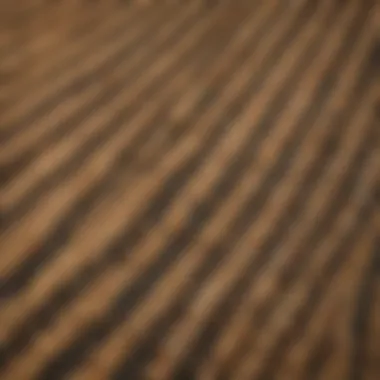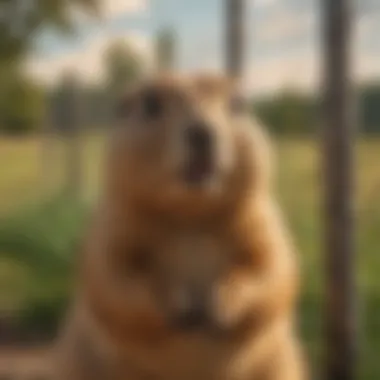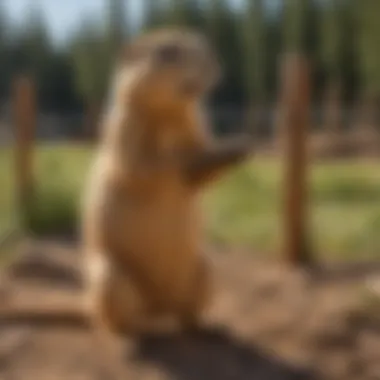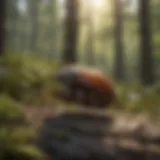Prairie Dog Fencing: Ecological Benefits and Techniques


Intro
The prairie dog fence stands as a notable structure within the panorama of American ecosystems. Designed primarily for wildlife management, its presence highlights the delicate balance that exists between human development and the natural behaviors of prairie dogs. As ecologists and forestry experts delve into the nuances of this fence's design and implementation, it becomes clear that addressing the myriad of ecological implications required a nuanced understanding. This intricate web of considerations extends not just to the prairie dogs themselves but also to the surrounding flora and fauna that coexist within these managed environments.
Through various construction methodologies, enthusiasts eagerly seek knowledge on how to erect robust fences. Furthermore, the impacts of these structures on local biodiversity—both positive and negative—merit careful examination. Maintenance practices are not merely about keeping a fence standing; they reflect an underlying philosophy aimed at promoting sustainable coexistence with wildlife.
In this article, we will navigate the multifaceted world of prairie dog fencing, witnessing first-hand how this solution can contribute effectively to both ecological stewardship and wildlife management. As we unpack this topic, the relevance of prairie dog fencing will shine through—encouraging professionals, conservationists, and nature lovers to reflect on its significance in our ever-evolving relationship with nature.
Intro to Prairie Dog Fencing
In recent years, the importance of prairie dog fencing has garnered significant attention, especially among those who navigate the intricacies of wildlife management and land use. Prairie dogs are often seen as both iconic and controversial figures in the American landscape. Their burrows create unique ecosystems, but as any land manager will tell you, they can also pose challenges conducive to agricultural impacts. Thus, understanding the practice of prairie dog fencing is not just beneficial, it's essential for a harmonious coexistence between their thriving colonies and human interests.
Understanding Prairie Dogs
Prairie dogs are small, social rodents belonging to the family Sciuridae and are native to the grasslands of North America. As charming as they might seem, these creatures can dramatically influence their environments. They live in colonies that can stretch over expansive areas, turning the dirt into a veritable Swiss cheese with numerous burrows and nests. Through their foraging and digging, prairie dogs aerate the soil and promote biodiversity; however, this can lead to conflicts with farmers and ranchers.
The prairie dog communities help sustain many other species that rely on them for food or habitat. For instance, hawks, badgers, and even foxes often take advantage of the protection and richness found in prairie dog towns.
The Need for Fencing
So why is fencing necessary? For starters, effective fencing mitigates the damage done by these animals to crops and improves the management of livestock operations. As anyone dealing with land management knows, boundaries can be crucial.
Fencing serves several practical purposes:
- Protection of Agricultural Lands: By placing barriers, landowners can protect valuable crops from voracious prairie dog populations that nip at the roots before they even have a chance to grow.
- Wildlife Management: Fencing also helps in directing prairie dog populations, effectively managing where they can burrow and build their colonies.
- Safety Considerations: Fences can prevent prairie dogs from burrowing near roadways, avoiding potential accidents involving wildlife and vehicles.
The fencing itself, however, is not a set-and-forget solution. As ecosystems are continually changing due to both natural and human influences, maintaining these structures becomes vital to ensure their effectiveness and sustainability.
"Understanding the relationship between prairie dogs and their environments is key to implementing successful management strategies."
In summary, prairie dog fencing intertwines ecological understanding with practical land management strategies, fulfilling essential functions for both wildlife and agriculture. As we dive deeper into the specifics of how these fences are created, maintained, and their ecological impacts, it becomes clear that this topic warrants a thorough exploration.
The Fundamental Principles of Prairie Dog Fencing
The establishment of a prairie dog fence involves a blend of practical engineering and ecological mindfulness. This section emphasizes the core principles that guide the design and implementation of fencing as a means of wildlife management. Understanding these principles is crucial not only for effective usage but also for minimizing negative impacts on the prairie dog populations and their habitat.
Types of Fencing Materials
Selecting the right materials is paramount in building a fence that withstands the test of time and environment. Various materials are available, each with their own advantages and shortcomings.
- Wood: Traditionally used, wood offers natural aesthetics but can deteriorate quickly when exposed to moisture and pest infestations. While it’s easy to work with, it often needs regular treatments to prolong its lifespan.
- Chain Link: A durable option that allows visibility while providing a strong barrier against larger predators. However, the gaps may not deter smaller animals, so additional measures might be needed.
- Barbed Wire: Designed mainly for livestock containment, barbed wire isn’t typically recommended for prairie dog fencing due to the potential harm to these small creatures. Careful consideration must be made if this is chosen.
- Plastic Mesh: Lightweight and often more affordable, plastic mesh can be an effective barrier against small animals. It’s resistant to rust and decay, but may not hold up against larger wildlife.
Choosing the right material requires careful evaluation of the surrounding environment, as well as the specific needs of prairie dog habitats. Consideration of durability, maintenance, and potential ecological impact is essential in this decision-making process.
Design Considerations
The design of the fence goes beyond mere construction; it is about creating a framework that complements the ecosystem. Here are some vital elements to consider:


- Terrain Assessment: Understanding the landscape is crucial. Fencing should mimic natural barriers where possible, making it less intrusive.
- Access Points: It’s vital to create designated openings for wildlife movement. Contemplating animal behavior can assist in determining where these might be necessary.
- Spacing: The distance between fence posts should support the overall structure without compromising integrity; placing them too far apart may cause sagging and subsequent weaknesses.
- Aesthetic Integration: The overall look of the fence should align with the natural beauty of the prairie. Utilizing natural colors and materials can result in a more harmonious landscape.
These design considerations form the backbone of successful prairie dog fencing, promoting both durability and ecological sensitivity.
Height and Depth Specifications
It's not just about building a fence; it’s about building the right fence. The height and depth are critical factors that determine the effectiveness of the barrier.
- Height: Typical recommendations suggest a minimum height of 36 inches to deter larger animals while allowing younger prairie dogs to safely navigate them. This height also serves to minimize accidental climbs by other wildlife.
- Depth: A standard depth of at least 18 inches is often advised. This deters burrowing animals from undermining the fence. Additionally, a proper depth takes into consideration the natural behavior of prairie dogs, who may dig around barriers if not adequately secured.
Constructing a fence with the right height and depth can significantly reduce unwanted animal incursions and contributes to a more secure environment for the prairie dogs.
Building a fence is not merely a matter of privacy; it reflects an understanding of how we engage with wildlife and influence habitat.
In summary, the fundamental principles of prairie dog fencing intertwine practical construction methods with a broader ecological perspective. By thoughtfully selecting materials, considering design features, and adhering to height and depth guidelines, we can create barriers that protect both prairie dogs and the integral ecosystems they inhabit.
Construction Techniques for Prairie Dog Fences
Building effective prairie dog fences is crucial, not just for the delineation of wildlife areas, but also for maintaining ecological balance. If constructed poorly, these fences might do more harm than good, creating barriers that disrupt the natural behaviors of various species. The stakes are high; careful attention to construction techniques can lead to success in managing prairie dog populations effectively while ensuring minimal disruption to other wildlife. In this section, we will explore the essential steps in the construction of these fences, including site assessment, the installation process, and important safety protocols.
Site Assessment and Preparation
Before diving into the physical construction of a prairie dog fence, a thorough site assessment is key. This process involves examining the area where the fence will be built to identify various environmental factors, such as soil type, slope, vegetation, and existing wildlife trails.
- Soil Type: Knowing whether the soil is sandy, clay-rich, or loamy can greatly affect the methods and types of materials used in fencing. For instance, sandy soils may require deeper posts to ensure stability, while clay may provide a firm embedment for shorter posts.
- Slope: The terrain may also influence design. Steep slopes can complicate construction and may necessitate additional support structures or different fencing designs.
- Vegetation: Understanding local flora helps in minimizing habitat disruption. This includes preserving native plants and avoiding areas that may be critical for other wildlife.
Once the assessment is done, preparation of the site follows. This often involves clearing debris, marking the boundary lines, and ensuring correct measurements to align the fence properly with the geography of the area, hence preventing any unintended wildlife entrapment.
Installation Process
Installing a prairie dog fence is not just hammering in posts and stretching wire; it requires a precise approach to ensure long-lasting durability and functionality. The general process includes the following steps:
- Post Setting: Begin by placing fence posts at regular intervals, typically 6 to 8 feet apart. Depending on the type of fencing material, the posts need to be embedded sufficiently into the ground. A depth of 2 to 3 feet is standard to endure wind forces and prairie dog burrowing activity.
- Fencing Material: Use wildlife-friendly materials that discourage climbing and tunneling. Metal mesh combined with barbed wire or reinforced fences has proven effective. Ensure the materials are treated to withstand weather elements, such as rusting or rotting, which could lead to costly repairs.
- Tensioning: Once the posts are installed, the fencing material needs proper tensioning. A taut fence prevents prairie dogs from digging underneath and dislodging the structure.
- Gate Installation: Don’t forget to account for access points when building the fence. Installing robust gates allows for maintenance until nearby habitats without compromising the fence's integrity.
Safety Protocols during Installation
Safety during the installation process cannot be overstated. Whether it's for the installers or the surrounding wildlife, taking proactive steps is necessary:
- Personal Safety Gear: Ensure that all workers wear proper safety equipment: helmets, gloves, and durable footwear to prevent injuries during installation.
- Wildlife Protection: Educate the installation team about local wildlife.
- Tool Safety: Hand and power tools pose significant risks. Ensure all tools are maintained in good working order and that team members are properly trained in their use.
- Daily checks: Routine wildlife inspections should be made prior to installation, ensuring no animals are present in the vicinity.
- Signage: Placing signs around the work area can alert others to possible wildlife activity, limiting mishaps during construction.
If these construction techniques are followed diligently, the result can be a well-built prairie dog fence that provides the necessary control over prairie dog activity while promoting an ecosystem that supports a diversity of wildlife.
Proper planning and execution are vital to ensure the success of prairie dog fencing in promoting ecological balance.
Ecological Impacts of Prairie Dog Fencing
The ecological impacts of prairie dog fencing are crucial for understanding how these structures influence the delicate balance of local ecosystems. Fencing isn't just about containing prairie dogs; it's about recognizing the intricate web of life that such measures affect. When considering fencing, it’s vital to look at both the intended outcomes and the potential consequences. The implications stretch beyond individual species, necessitating a holistic view of habitat dynamics and wildlife interactions.


Impact on Prairie Dog Populations
The first step in grasping the ecological significance of fencing is to evaluate its direct impact on prairie dog populations themselves. Fencing can significantly alter the way prairie dogs interact with their environment and each other. For instance, if the fence limits access to essential resources such as food and water, it can lead to a decline in their overall health and reproductive success. There's a fine line between protecting these creatures from external threats, like predators or vehicles, and restricting their natural behavior. Despite these challenges, properly designed fencing can aid in population management, allowing for controlled growth while mitigating the risk of habitat degradation in other areas.
"Fencing can serve as both a protector and a constraint, striking a delicate balance in prairie ecosystems."
Effects on Other Wildlife Species
Fencing does not merely exist in a vacuum; it affects a myriad of other wildlife species that share the prairie habitat. The barriers can obstruct migratory paths or disrupt the movement of larger animals, such as deer or elk, which might depend on open spaces for feeding. This restriction can create a ripple effect; for instance, it can lead to increased competition for resources among species that can still traverse the area. Additionally, smaller mammals or ground-nesting birds may experience changes in predation dynamics due to the concentration of certain species created by fencing. While some adaptations can occur, not all wildlife can navigate around these new obstacles easily.
- Key considerations include:
- Changes in migratory patterns
- Alterations in food chains and predator-prey relationships
- Possible increase in human-wildlife conflicts when animals venture into populated areas in search of resources
Influence on Habitat Integrity
The integrity of the habitat itself must also be taken into account when erecting prairie dog fences. There’s often a misconception that fencing solely serves to confine animals, but it can also protect or enhance habitat quality in certain contexts. For instance, by managing prairie dog populations effectively, fencing can prevent overgrazing in sensitive areas, allowing vegetation to recover and support a more diverse range of species. Nevertheless, if fencing contributes to habitat fragmentation or isolates populations, it can severely damage ecological balance, leading to loss of biodiversity.
- Considerations for maintaining habitat integrity include:
- Assessing the impacts on soil health and flora availability
- Monitoring changes in ecosystem resilience
- Incorporating wildlife corridors where necessary to enhance connectivity
Maintenance of Prairie Dog Fences
Effective maintenance of prairie dog fences is not just a matter of aesthetics; it plays a pivotal role in ecological preservation and wildlife management. These structures are essential in managing prairie dog populations, protecting surrounding wildlife, and safeguarding the habitats that various species depend on. Regular upkeep ensures that the fences remain functional, thus aiding the stabilization of ecosystems by preventing overpopulation or unwanted dispersal of prairie dogs. In this section, we will explore the crucial aspects of maintenance, shedding light on the methods that help ensure the longevity and effectiveness of these barriers.
Regular Inspections
Regular inspections stand as one of the cornerstones of effective fence maintenance. Conducting these checks can help identify weaknesses or potential breaches before they escalate into significant issues. Ideally, these inspections should feature a thorough examination of both the physical structure and the surrounding environment.
- Physical Condition: Look for any signs of wear, such as rusted materials or loose wires that might allow prairie dog access. Take note of any sections that have sagged or become uneven; these can be telltale signs of the need for immediate care.
- Environmental Factors: Seasonal changes can impact the integrity of fencing. Heavy rains, high winds, or even critter activity may create unexpected problems. It's important to be mindful of how these factors can introduce strain on the fence itself.
Setting a consistent timeline for inspections is key. Depending on regional climate and local wildlife behaviors, monthly or bi-monthly checks might be prudent. As a rule of thumb, the earlier you catch potential problems, the easier— and often cheaper— they are to fix.
"An ounce of prevention is worth a pound of cure." - Benjamin Franklin.
Repairs and Upkeep Considerations
When it comes to repairs, prompt action is essential. Delaying repairs can lead to more extensive damage, which in turn can result in higher costs and further ecological issues. Here are some considerations that should guide maintenance decisions:
- Material Replacement: If a section of the fence is beyond simple repairs, replacing it entirely may be necessary. This might entail not just new fencing materials but also ensuring the new setup aligns with the original design concerning height and depth to prevent prairie dogs from tunneling underneath.
- Weatherproofing: Applying protective coatings or treatments to materials can greatly enhance their longevity, especially in regions that experience severe weather conditions.
- Wildlife Monitoring: Keeping an eye on the species that interact with the fencing is crucial. If regular inspections reveal signs of struggle from other wildlife, it may prompt reevaluation of the fencing design to ensure it aligns with local ecological needs.
- Documentation: Recording inspection and repair data builds a history of the fence’s lifecycle, allowing for better prevention and maintenance strategies in the future.
Legal and Ethical Considerations
Understanding the legislative and moral framework surrounding prairie dog fencing is key to effective management. These considerations not only guide how to design and implement fences but also influence the larger conversation about wildlife conservation and habitat integrity. Laws and ethical responsibilities should be seen as intertwined threads in the fabric of prairie dog management.
Regulations Governing Fencing


When it comes to building fences around prairie dog colonies, regulations can vary widely by state and federal laws. The U.S. Fish and Wildlife Service has specific criteria to ensure that the construction does not negatively impact endangered species or prevent migration routes of indigenous wildlife.
Here are few important points to consider regarding regulations:
- Permit Requirements: In many regions, obtaining a permit is crucial before erecting any kind of barrier. This is to ensure that the local ecology isn’t adversely affected.
- Types of Allowed Construction: Some areas strict about the types of materials that can be used. For instance, metal and wood are commonly permitted, while barbed-wire may be restricted to prevent injury to other species.
- Height and Depth Guidelines: Certain regulations dictate how high and deep the fence should be. This is particularly relevant for protecting prairie dogs from predators while enabling smaller wildlife to pass.
- Maintenance and Reporting: Ongoing maintenance of fences may also fall under regulatory scrutiny. Regular reporting on the condition of the fence could be mandated to ensure compliance with ecological standards.
"Laws are like cobwebs, which may catch small flies, but let wasps and hornets break through." - Jonathan Swift
To navigate these regulations effectively, consulting local wildlife agencies is prudent. They can provide comprehensive guidance tailored to the region, ensuring that fencing efforts comply with current laws.
Ethical Responsibilities towards Prairie Dogs
Aside from legal frameworks, ethical considerations loom large in any discussion about managing prairie dog fencing. Prairie dogs are often referred to as a keystone species—meaning their existence supports a myriad of other wildlife and plant life in the ecosystem.
Here are some ethical considerations to keep in mind:
- Habitat Preservation: It’s essential to recognize that while fencing is designed to protect prairie dogs, it should not either fragment habitats or restrict movement. An ethically constructed fence will allow other species to thrive while safeguarding the colony.
- Human-Wildlife Conflict: Understanding that prairie dog populations can lead to conflicts with agricultural interests, management should focus on humane solutions. Instead of eradicating populations, fencing should aim to guide them or minimize disruption to local farming activities.
- Community Engagement: Involving local communities in the decision-making process can enhance both compliance and ethical responsibility. When people understand the ecological role of prairie dogs, they may become advocates rather than adversaries.
- Educational Initiatives: Promoting awareness about prairie dogs and their environmental impacts can foster a respectful coexistence. Educational programs may provide the general public with insights into the significance of preserving these animals and their habitats.
Real-World Case Studies
Case studies offer a valuable lens through which we can understand the practical implications of prairie dog fencing. They reveal both successes and hurdles encountered in real scenarios, providing insights that can be leveraged for future fencing projects. By examining specific examples, forestry professionals and conservationists can better grasp the effectiveness, adaptability, and potential pitfalls of these fencing strategies. Additionally, the narrative formed by these cases adds depth to the theoretical aspects explored earlier in the article, making the concept of prairie dog fencing more relatable and actionable.
Successful Fencing Projects
In various regions of the U.S., successful prairie dog fencing projects have highlighted the positive outcomes of proper implementation and community engagement. One such project occurred in the Black Hills of South Dakota, where a local conservation initiative sought to manage prairie dog populations while preventing conflicts with livestock grazing.
- Collaborative Efforts: The project emphasized teamwork between ranchers, local government, and conservationists. By prioritizing open communication, they were able to address concerns regarding livestock safety while also acknowledging the ecological role of prairie dogs.
- Design Considerations: The fencing was constructed using a combination of barbed wire and electric fencing, standing six feet tall to discourage predators while allowing other wildlife to pass through safely. This reinforced the idea that fences could serve dual purposes without excluding other species.
- Positive Impact on Biodiversity: The successful management of prairie dog populations through this fencing also fostered the recovery of other species, such as the burrowing owl, which thrives in environments where prairie dogs are present.
Such projects illustrate how careful planning and community involvement can lead to beneficial outcomes for both prairie dogs and surrounding ecosystems.
Lessons Learned from Failed Installations
While there are numerous success stories, it is crucial to analyze cases where implementations did not go as planned. Learning from failure can be as beneficial as celebrating success. One notable example occurred in Colorado, where an ambitious fencing project aimed at managing prairie dog populations failed to account for several critical factors.
- Inadequate Resources: The initial budget was underestimated, leading to subpar materials being used. Over time, the lack of durability in the fencing allowed prairie dogs to dig under and escape, essentially negating the purpose of the fence.
- Ignoring Local Ecology: The project didn't take local wildlife dynamics into account. For example, predators like coyotes began to exploit the negligence in the installation, creating even more significant imbalances in the ecosystem than previously present.
- Community Disengagement: The lack of stakeholder involvement meant that ranchers were left in the dark about the implications the fences would have on their land. Frustration among the local community resulted in resistance to future projects, as trust had been eroded through this failed initiative.
By examining these failures, it's evident that thorough planning, community involvement, and an understanding of the local ecological context are paramount to the success of prairie dog fencing projects. Integrating the lessons learned from these failed installations could pave the way for more effective fencing strategies in the future.
Ending
The conclusion serves as the final thread stitching together the diverse themes discussed in this article. It encapsulates the significance of prairie dog fencing in wildlife management and ecosystem preservation. Understanding this topic is pivotal for forestry professionals and conservationists alike as they navigate the intricate interplay between human activities and wildlife habitats.
Summary of Key Points
Over the course of this exploration, several critical elements emerged regarding prairie dog fencing. Here’s a concise recap:
- Prairie Dog Insights: Recognizing the ecological role of prairie dogs is essential for informed management. Their burrowing behavior and social structure contribute to the health of grassland ecosystems.
- Fencing Dynamics: Various fencing types, as discussed, show varying effectiveness. The right choice hinges on both ecological considerations and specific wildlife management goals.
- Installation Practices: Proper techniques during the installation of fences create not only functional barriers but also preserve the surrounding landscape and minimize disruption to other species.
- Maintenance Needs: Regular upkeep of fences is paramount. Inspections and repairs safeguard both the barriers themselves and the integrity of wildlife populations.
- Ecological Consequences: The impact of fencing extends beyond prairie dogs. It’s vital to consider how these structures influence neighboring wildlife and overall habitat integrity.
- Legal and Ethical Obligations: Navigating the legal landscape surrounding wildlife management is a necessity for practitioners to adhere to regulations and uphold ethical standards.
Future Directions for Prairie Dog Management
Looking ahead, several considerations must shape future prairie dog management strategies. There is an undeniable need for ongoing research to refine fencing techniques that are less invasive and more considerate of entire ecosystems. Possible avenues include:
- Innovative Fencing Solutions: Exploring new materials or designs that can deter prairie dogs without obstructing other wildlife. This could mean lighter, more permeable structures that allow for the migration of various species.
- Integrated Management Approaches: Coordinating with local and national wildlife agencies to adopt comprehensive management plans that consider the broader ecological impacts will be essential. This could lead to more sustainable coexistence between prairie dogs, livestock, and other wildlife.
- Community Engagement: Involving local communities in prairie dog management can foster understanding and support. Educational initiatives aimed at raising awareness about the ecological importance of prairie dogs can create more sympathetic human-wildlife interactions.
- Long-Term Studies: Implementing longitudinal studies to assess the impacts of fencing over time will be key. This data can provide insights to improve future practices and inform policy decisions.
In summary, the journey of understanding and managing prairie dog populations through structured fencing is far from complete. Embracing an adaptive, science-informed approach will be crucial for future generations who strive for ecological balance in a changing world.



